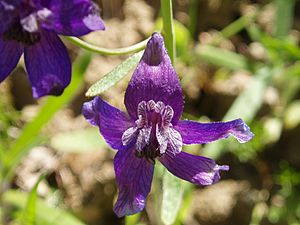Royal larkspur facts for kids
Quick facts for kids Royal larkspur |
|
|---|---|
 |
|
| Scientific classification | |
| Genus: |
Delphinium
|
| Species: |
variegatum
|
Delphinium variegatum is a beautiful wildflower often called the royal larkspur. It's a special plant because it only grows in California, which means it's endemic to that state. You can find it in different places like mountains, valleys, and along the coast. It likes to grow in woodlands (areas with trees) and grasslands (open areas with grass). In California's oak forests, you might see it growing near other plants like Calochortus luteus, Cynoglossum grande, and Calochortus amabilis.
What Does Royal Larkspur Look Like?
This tall wildflower can grow up to half a meter (about 20 inches) high. Its leaves have deep cuts or "lobes" that sometimes overlap. The long stems that connect the leaves to the main plant are called petioles, and they are usually hairy.
The plant has a branching flower cluster called an inflorescence. This cluster can hold up to 25 flowers, which are usually spaced far apart. Most of the flowers are a bright, deep blue. Sometimes, you might see lighter blue or even white ones, depending on the specific type of plant. Each flower has a "spur," which is a long, hollow part at the back. This spur is usually between one and two centimeters long.
Different Types of Royal Larkspur
Scientists recognize three main types, or "subspecies," of royal larkspur. These are like different versions of the same plant.
- ssp. kinkiense
- ssp. thornei
- ssp. kinkiensis
Two of these subspecies, ssp. kinkiense and ssp. thornei, are found only on San Clemente Island. This island is one of the Channel Islands of California.
Ssp. kinkiensis is sometimes called Delphinium kinkiense ssp. kinkiense. It is listed as a federally endangered species. This means it is protected by the government because there are very few of these plants left. Even though ssp. thornei is actually rarer than ssp. kinkiensis, it does not have the same federal or state protection.
Unlike the other two subspecies, ssp. kinkiensis can sometimes have white flowers. It can be hard to tell the difference between blue-flowered ssp. kinkiensis and ssp. thornei.

